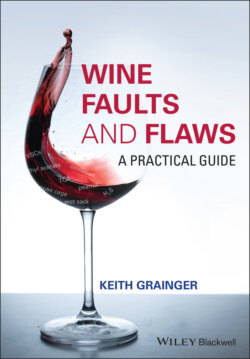Читать книгу Wine Faults and Flaws - Keith Grainger - Страница 66
2.6 Nose
ОглавлениеThe second stage in a tasting assessment is to nose the wine. The olfactory epithelium, situated at the top of the nasal cavity, is a very sensitive organ. The tongue reveals only a very limited number of tastes, and most of the ‘taste’ sensations are detected by the receptor cells of the olfactory epithelium, received either via the nasal or retro‐nasal passage. The information is turned into electrical signals and sent via the olfactory bulb to the olfactory cortex in the brain. There is a difference between the impressions of aromas obtained nasally and retro‐nasally, and the sensations transmitted via the retro‐nasal passage will be discussed later in this chapter. There is no doubt that repeated and overexposure to particular smells reduces sensitivity to them, and this can be an issue for winemakers who are regularly exposed to odours such as sulfur dioxide (SO2), or whose cellars are contaminated with haloanisoles (see Chapter 3).
When nosing a wine, we are smelling the headspace in the glass, above the surface of the liquid. There must be plenty of headspace for the aromas, the volatile compounds in the wine, to develop. The inwards tapering bowl of a well‐designed tasting glass (narrower at the top than the bottom) enables aromas to be retained in the headspace.
The nose of the wine should be assessed in the following stages:
Condition;
Intensity;
Aroma characteristics;
Development.
As discussed below, the wine should be first nosed without swirling, then swirled around the glass to vaporise the volatile compounds, and then given a comprehensive nosing.
